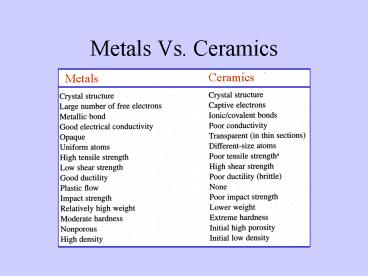Metals Vs' Ceramics - PowerPoint PPT Presentation
1 / 22
Title:
Metals Vs' Ceramics
Description:
Advanced ceramic materials have been developed over the past half century ... key areas of Hercules aircraft (cockpit crew/instruments and loadmaster station) ... – PowerPoint PPT presentation
Number of Views:446
Avg rating:3.0/5.0
Title: Metals Vs' Ceramics
1
Metals Vs. Ceramics
2
Properties And Use Of Ceramic Materials
3
Advanced Ceramics
- Advanced ceramic materials have been developed
over the past half century - Applied as thermal barrier coatings to protect
metal structures, wearing surfaces, or as
integral components by themselves. - Engine applications are very common for this
class of material which includes silicon nitride
(Si3N4), silicon carbide (SiC), Zirconia (ZrO2)
and Alumina (Al2O3) - Heat resistance and other desirable properties
have lead to the development of methods to
toughen the material by reinforcement with fibers
and whiskers opening up more applications for
ceramics
4
Engine Components
Rotor (Alumina)
Gears (Alumina)
5
Turbo Charger
Ceramic Rotor
6
Candidate Materials for Turbocharger
g/cm3
MPa
GPa
(1000C)
7
Glasses and Glass Processing
8
Compositions of Commercial Glasses
9
Pressed Glass Processing
Softened Gob
10
Blow Molding
Softened glass
11
Plate Glass Drawing Processes
12
Tempered Glass
Small Scratches
- The strength of glass can be enhanced by inducing
compressive residual stresses at the surface. - Two methods are used
- Thermal Tempering
- Chemical Hardening
- The surface stays in compression - closing small
scratches and cracks.
13
Hardening Processes
- Tempering
- Glass heated above Tg but below the softening
point - Cooled to room temp in air or oil
- Surface cools to below Tg before interior
- when interior cools and contracts it draws the
exterior into compression. - Chemical Hardening
- Cations with large ionic radius are diffused into
the surface - This strains the lattice inducing compressive
strains and stresses.
14
Ceramic Processing
15
Slip Casting
Sinter and Serve
16
Powder Pressing Process
Filling Mould
Green part ejected - then sintered
Compaction
17
Sintering Process
Pressed Ceramic Particles
Sintered for a short time
Sintered for a long time
18
Glass Ceramics
- These are primarily silicates containing oxides
such as Alumina (AL2O3), TiO2, LiO2, and others.
- In amorphous form, the glasses are transparent.
Most glasses can be made to transform into a
polycrystalline state by a suitable
heat-treatment process, called devitrification. - An initiator, such as TiO2, is added to begin the
nucleation of ceramic crystals. The product is
called a glass ceramic. - Desirable properties include high strength and
thermal conductivity, low thermal expansion,
resistant to thermal shock, ease of fabrication.
using conventional methods.
19
Refractories
- Used to provide thermal protection of other
materials in very high temperature applications,
such as steel making (Tm1500C), metal foundry
operations, etc. - They are usually composed of alumina (Tm2050C)
and silica along with other oxides MgO
(Tm2850C), Fe2O3, TiO2, etc., and have
intrinsic porosity typically greater than 10 by
volume. - Specialized refractories, (those already
mentioned) and BeO, ZrO2, mullite, SiC, and
graphite with low porosity are also used.
20
Ceramic - Composite Armor
21
Ceramic Armor
- Ceramic armor systems are used to protect
military personnel and equipment. - Advantage low density of the material can lead
to weight efficient armor systems. - Typical ceramic materials used in armor systems
include alumina, boron carbide, silicon carbide,
and titanium diboride. - The ceramic material is discontinuous and is
sandwiched between a more ductile outer and inner
skin. - The outer skin must be hard enough to shatter the
projectile.
22
- Most of the impact energy is absorbed by the
fracturing of the ceramic and any remaining
kinetic energy is absorbed by the inner skin,
that also serves to contain the fragments of the
ceramic and the projectile preventing severe
impact with the personnel/equipment being
protected. - CF uses alumina ceramic/Kevlar composite system
in sheets about 20mm thick and having a bulk
density of about 2.5 g/cm3 to protect key areas
of Hercules aircraft (cockpit crew/instruments
and loadmaster station). - This lightweight solution provided an efficient
and removable/replaceable armor system. Similar
systems used on APCs































